Holkham Beach and Nature Reserve
Pinewoods and scrub

The silence of the pinewoods comes as a surprise after a walk along the shore. The cushion of needles absorbs every footfall and the high canopy keeps away the wind. So the scurry of a Grey Squirrel or the cone-tearing activity of a flock of Crossbills can sound like a riot. Three kinds of pines grow in the woods, Corsican (grey trunk, small cones), Scots (orange upper trunk) and Maritime (large cones in tree-top clusters). The pines were planted in the late 19th century, over a period of 20 years or so by the 2nd Earl of Leicester.
The dense shade and thick carpet of needles make life difficult for most other plants but there are a few specialities, such as the pretty little Creeping Lady’s-tresses Orchid and Yellow Bird’s Nest. Where the canopy lets in a little more light there are patches of bramble, Privet and Honeysuckle and on the wood edge there are even some Holm Oaks planted by the 3rd Earl of Leicester who brought them over from Holkham Park where they had grown since being imported from the Mediterranean in the 18th Century.



Woodland insects:
- Broad-bordered Bee and Humming Bird Hawk-moths visit Red Campion flowers in the spring.
- Dragonflies, especially Ruddy darter, Migrant Hawker and Southern Hawker are around through summer and autumn.
- Scarce butterflies include Dark Green Fritillary and White-letter Hairstreak.
- Big furry caterpillars basking in the sunshine will probably be Drinker-moth or Fox-moth. Bottle-Brush, tufted caterpillars in a hurry will be White Ermine.
- Sand-dune sun-traps are always busy with hunting wasps and solitary bees, making their nests in burrows. Robber Flies and Assassin Flies sit around waiting for prey.



